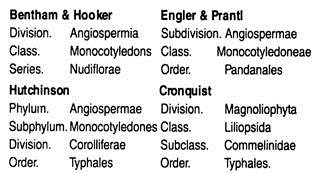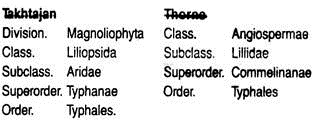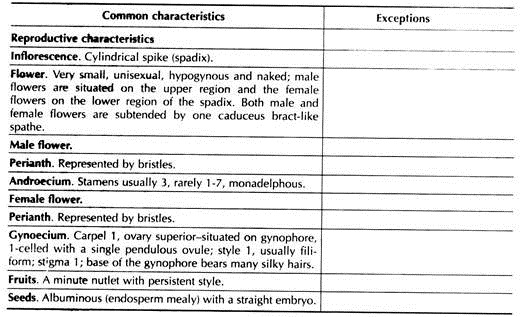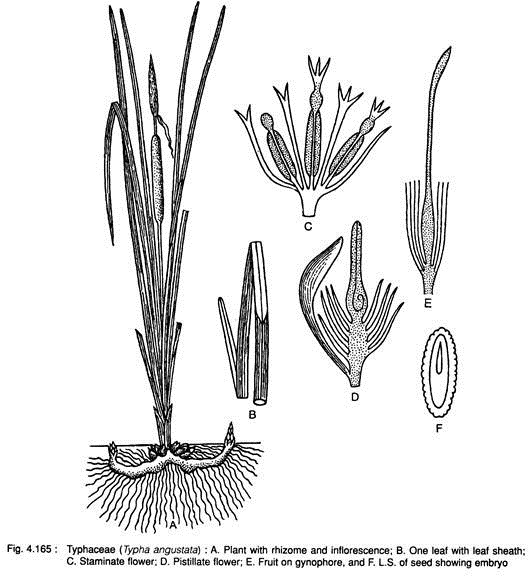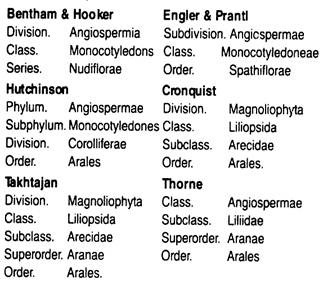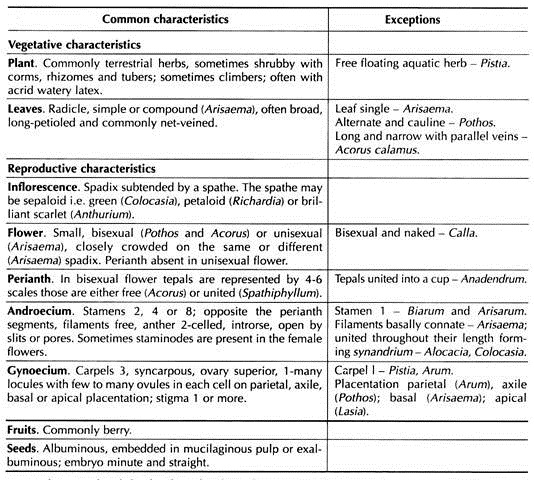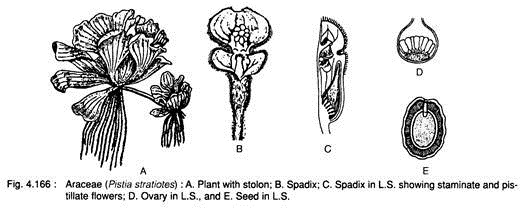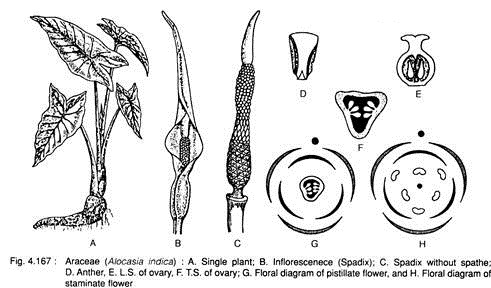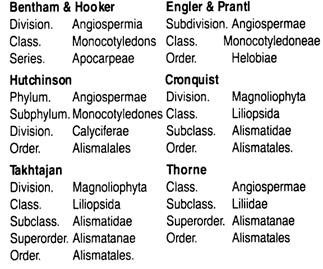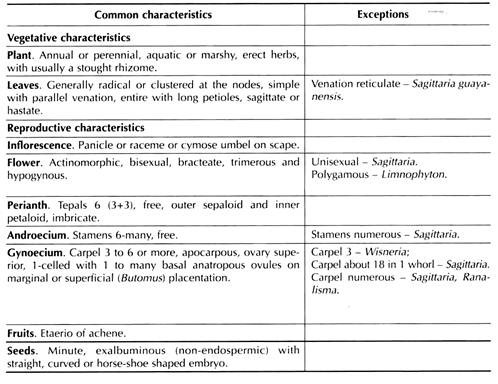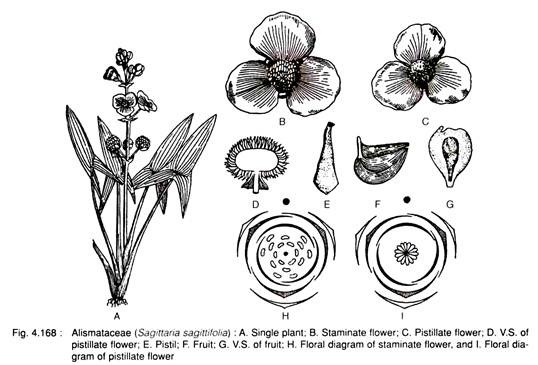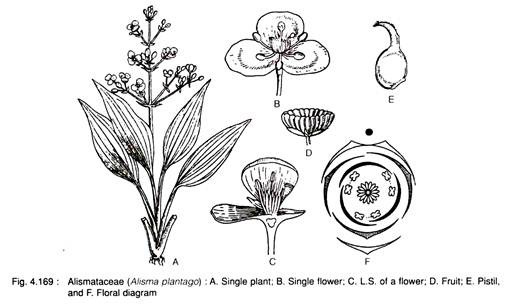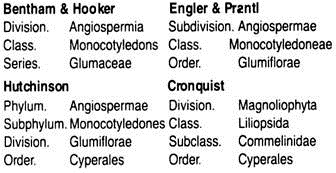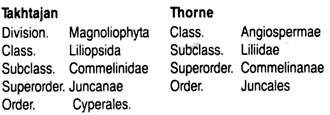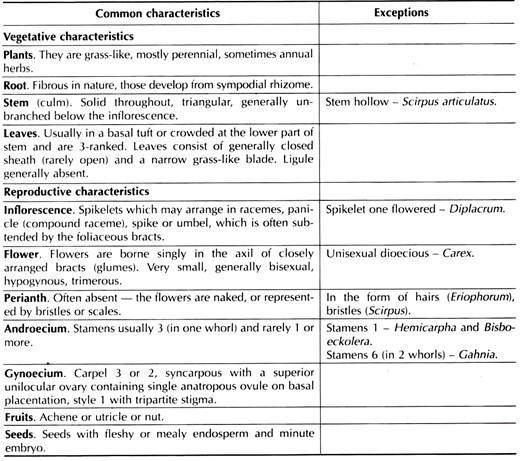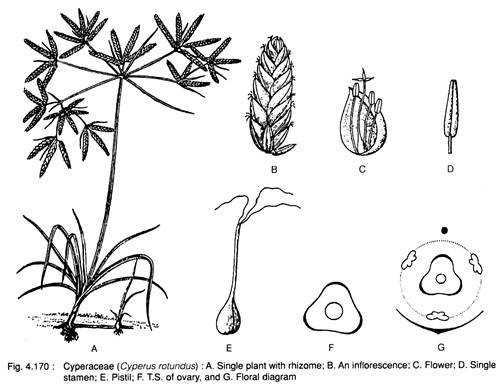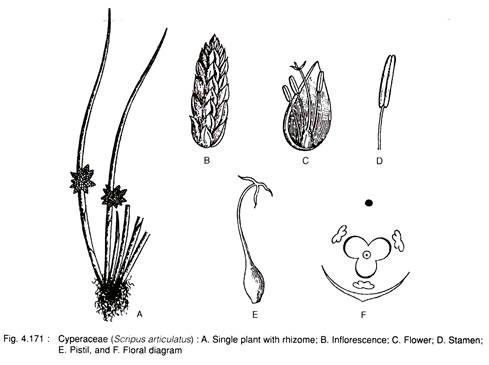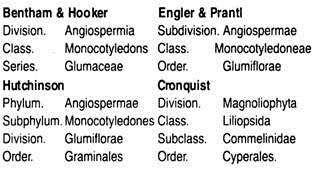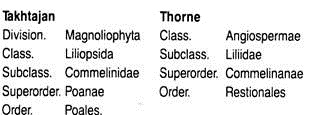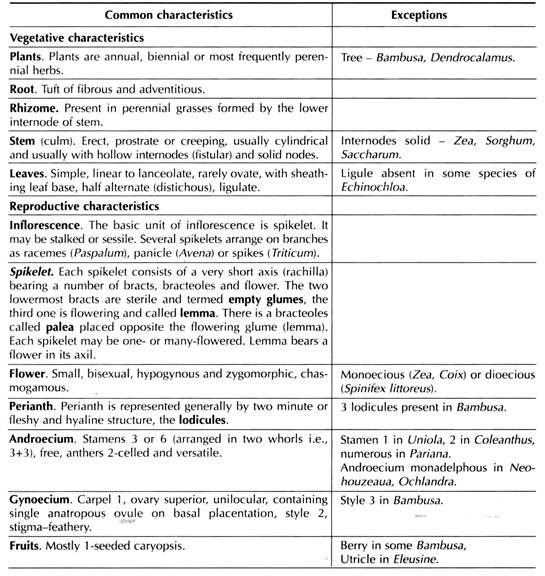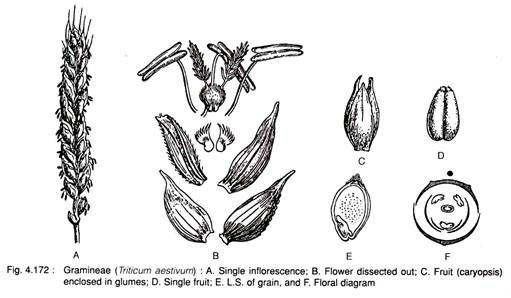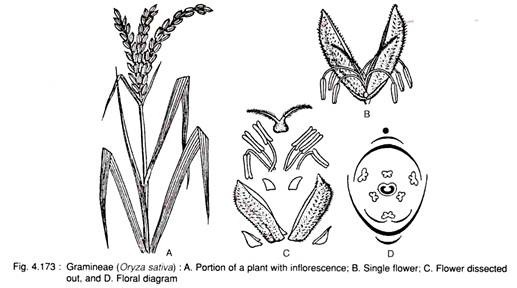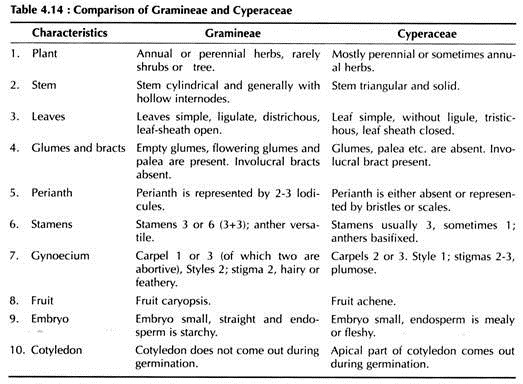Here is an essay on the ‘Families of Monocotyledons’ fro class 11 and 12. Find paragraphs, long and short essays on the ‘Families of Monocotyledons’ especially written for school and college students.
Families of Monocotyledons
Essay Contents:
- Essay on Typhaceae (Cattail Family)
- Essay on Araceae (Arum Family)
- Essay on Alismataceae (Water plantain Family)
- Essay on Cyperaceae (Sedge Family)
- Essay on Gramineae (Poaceae)
Essay # 1
. Typhaceae (Cattail Family) :
The family Typhaceae is a monotypic family consisting of only one genus Typha and about 15 species distributed in tropical and temperate regions of the world. In India, the family is represented by 2 species — T. angustata Chaub. and Bory and T. elephantina Roxb.
The type genus of the family is Typha.
Systematic Position:
Typhaceae: Distinctive Features:
Identifying Characteristics:
1. Perennial herbs with creeping rhizomatous stem;
2. Leaves simple, erect, very long, linear, sessile with sheathing leaf-base, mostly radicle and spongy.
3. Inflorescence cylindrical spike (spadix).
4. Flowers minute, unisexual, hypogynous and naked.
5. Perianth represented by bristles.
6. Male flowers commonly with 3 stamens, monadelphous.
7. Female flowers with 1 carpel, ovary superior situated on gynophore.
8. Fruit minute nutlet.
Floral Formula:
Phylogeny and Systematic:
The family is closely related to Pandanaceae and Araceae and is readily differentiated by its very long, linear and erect leaves and also the dense cyclindrical spike.
Bentham and Hooker placed Typhaceae under the series Nudiflorae of the class Monocotyledons. Engler and Prantl placed the family under the order Pandanales in the class Monocotyledoneae. Later, Hutchinson placed the family Typhaceae under the order Typhales in the division Corolliferae of subphyla Monocotyledones.
Recently Takhtajan (1980) placed the family under Typhales and placed it in subclass Arecidae under the class Liliopsida. Cronquist placed the family under the order Typhales like Takhtajan, but placed it in the subclass Commelinidae next to Hydatallales under the class Liliopsida. Recently, Taktajan (1997) placed the family under the order Typhales, superorder Typhanae and subclass Aridae under the class Liliopsida (Monocots).
Common Plants:
1. Typha angustata Chaub. & Bory;
2. T. elepbantina Roxb.;
3. T. latifolia L.
Plants of Economic Importance:
Economically, the family is not so important, but the long leaves of the 2 species — T. angustata and T. elephantina, are woven into flat sheet like structures and used in thatching of huts, boats, temporary shades etc. The pollens of T. angustata are sometimes made into cakes and mostly used by the poor people.
Essay # 2.
Araceae (Arum Family):
The family Araceae contains 104 genera and 3,040 species, grows mostly in the tropical regions of the world, out of which 24 genera and 136 species are found in India.
The type genus of this family is Arum.
Systematic Position:
Araceae: Distinctive Features:
Identifying Characteristics:
1. Mostly perennial herbs with rhizome, corms or tubers,
2. Leaves radical or cauline,
3. Flower bisexual or unisexual in spadix inflorescence,
4. Androecium – stamens 2, 4 or 6,
5. Gynoecium – carpel 1 or more, syncarpous,
6. Fruit – berry
Floral Formula:
Phylogeny and Systematic:
The family Araceae is closely related to Palmae (Arecaceae). It is also related with some members of the family Liliaceae.
Engler considered the family to be derived from the from Palmae (Arecaceae). Later, Hutchinson considered that they have been derived stocks ancestral to the Liliaceae. Still later, Takhtajan stated that they have a common origin with Arecales and Cyclanthales from immediate ancestors of Liliaceae.
Bentham and Hooker placed the family Araceae as a Natural Order Aroideae under the 5th series Nudiflorae, together with Lemnaceae in the Class Monocotyledons. Later, Engler placed the family in the 7th order Spathiflorae under the class Monocotyledoneae. But, Hutchinson placed the family in a separate order Arales close to Typhales in the subphylum Monocotyledones. Takhtajan and also Cronquist placed the family under the order Arales associated with Lemnaceae.
Common Plants:
1. Alocasia indica (Roxb.) Schott. (Man kachoo),
2. Arisaema album Brown,
3. A. costatum Mart.,
4. A. griffithii Schott.,
5. A. sikkimense Stapf ex. Chatterjee,
6. Colocasia esculenta (L.) Schott. – Kachoo, ghuina or arvi,
7. Typhonium trilobatum (L.) Schott.
Key to Genera:
I. Flowers Unisexual, Monoecious, Rarely Dioecious:
1. Aquatic plants
i. Floating stemless herbs; leaves sessile in a rosette-like tuft …………….. Pistia.
ii. Submerged aquatic or marsh herbs; leaves tufted from a buried rootstock …………………….. Cryptocoryne.
2. Terrestrial herbs
i. Tuberous; leaves entire, 3-5-lobed, cordate or hastate or pedate; flowers and leaves present together…………………………… Typhonium.
ii. Tuberous; leaves solitary, 3-partite, segment pinnatisect; flowers appearing without leaves, male and female flowers contiguous, neuter wanting ……………. Amorphophallus.
iii. Herbs usually tall, coarse; leaves and scapes arising from the rhizome; leaves may be peltate; spadix with a barren appendage, not adnate to the spathe –
a. Ovules few; basal ……… Alocasia.
b. Ovules many, parietal ……………….. Colocasia.
II. Flowers Bisexual:
1. Epiphytic climbing herbs
a. Perianth absent, berries free, ovule solitary ……………. Scindapsus.
b. Perianth of 4-6 segments, ovule solitary, plant unarmed ………… Pothos.
2. Stout spinous aquatic or marsh herbs …………… Lasia.
Plants of Economic Importance:
The members of this family are important in respect of food, medicines and ornamentals:
A. Food:
1. Alocasia indica, A. cucullata. The plants are cultivated for fleshy root stocks used as vegetables.
2. Amorphophallus campanulatus (Elephant foot). The large corm of this plant is used after boiling or used as vegetable.
3. Colocasia esculenta (Syn. Colocasia antiquorum). The plant is commercially cultivated for the starchy tuber used as food. The tubers are used in the production of industrial alcohol. The young leaves are used as vegetable.
4. Monstera deliciosa (Ceriman). The ripe fruits are edible.
5. Remusatia vivipara and Xanthosoma niger. Both corm and leaves of the plants are used as vegetable.
B. Medicine:
1. Acorus calamus. The rhizome is useful in chronic stomach troubles and dyspepsia. The aromatic volatile oil is used as insecticide against bugs, lice, etc.
2. Alocasia macrorrhiza. The juicy extract of the stem is used to relieve pain from scorpion attack.
3. Amorphophallus campanulatus (Elephant foot). The large corm of this plant is recommended for dysentery and piles.
C. Ornamental Plants:
1. Acorus calamus var. variegatus. The plants are grown in the garden for their ornamented leaves.
2. Alocasia indica var. metallica and A. lowii. The plants are grown in the garden for beautification.
3. Arisaema atrorubens. The plants are cultivated in the garden for their beautiful and attractive spathe.
4. Caladium bicolor and C. picturatum. The plants are cultivated in the garden for their thin coloured leaves.
5. Colocasia esculenta. Some varieties (Elephant’s ear) are grown in garden and also in tubs for their ornamental leaves.
6. Dieffenbachia picta. The plants are grown in tubs for their spotted and variegated leaves.
7. Pistia stratiotes (Water lettuce). These are floating herbs grown in aquaria, and also in garden water.
8. Pothos aureus (Money plant). Some varieties are climbers having variegated leaves, cultivated in the garden.
Essay # 3
. Alismataceae (Water Plantain Family):
The family is represented by 16 genera and 100 species — cosmopolitan in distribution. In India, the family is represented by 7 genera and about 10 species found to grow throughout the plains.
The type genus of the family is Alisma.
Systematic Position:
Alismataceae: Distinctive Features:
Identifying Characteristics:
1. Aquatic or marshy herbs.
2. Inflorescence on scape.
3. Flower unisexual or bisexual.
4. Perianths 6 in 2 whorls, outer sepaloid.
5. Stamens 6 to many.
6. Carpels few to many, apocarpous.
7. Fruits are etaerio of achene.
Floral Formula:
Phylogeny and Systematic:
The family Alismataceae is closely related to Ranunculaceae and also with Commelinaceae. Takhtajan (1959, 69) concluded that the order Alismales is linked with Nymphaeales. Further, he pointed out that there is no essential difference between the flowers of the Alismatales and Cabombaceae. Cronquist (1968) also had the same opinion.
Bentham and Hooker placed the family under the series Apocarpae. Later, Engler placed it under the order Helobiae. Still later, Hutchinson considered the family as a member under the order Alismatales. The placement of the family as made by Hutchinson was also accepted by Cronquist and Takhtajan. But Takhtajan named the order Alismales instead of Alismatales.
Common Plants:
1. Alisma plantago L. (Water plantain),
2. Butomopsis lanceolata Kunth.,
3. Limnophyton obtusitolium Miq.,
4. Sagittaria sagittifolia L. (Arrow-head),
5. 5. guayanensis H.B.K.
Key to Genera:
I. Flowers Hermaphrodite:
1. Fruit dehiscent of 6-7 follicles, stamens 8-12; ovules many ………. Butomopsis.
2. Fruit indehiscent of 3 or more achenes; stamens 6-9, ovule solitary ………….. Alisma.
II. Flowers Polygamous:
1. Unisexual flower, receptacle globose……………………… Sagittaria.
2. Bisexual flower, receptacle flat …………………………. Limnophyton.
Plants of Economic Importance:
Economically, the family is of little importance. Tubers of some species of Sagittaria are edible. A few species of Sagittaria and Alisma are grown in aquaria.
Essay # 4
. Cyperaceae (Sedge Family):
The family Cyperaceae includes 122 genera and 4,500 species, distributed widely throughout the world, out of which 22 genera and 405 species are found in India.
The type genus of the family is Cyperus.
Systematic Position:
Cyperaceae: Distinctive Features:
Identifying Characteristics:
1. Plants rhizomatous,
2. Stem (culm) solid and triangular,
3. Leaves crowded on the lower part of the culm; 3-ranked in a tristichous (⅓rd phyllotaxy), without ligule,
4. Flowers are in spikelets,
5. Stamens – usually 3, anther basifixed, dithecous (2-celled),
6. Carpel – 2-3, syncarpous, style-one with 2-3 stigma,
7. Fruit – achene.
Floral Formula:
Phylogeny and Systematic:
The family is closely related with Gramineae (Poaceae). The chemical similarities between the two families (Cyperaceae and Gramineae) indicate their phyletic unity than convergence (Cronquist, 1981) and the Cyperaceae have been derived from Juncaceae (Takhtajan and Cronqiust).
Bentham and Hooker placed the family Cyperaceae in the last (7th) series Glumaceae under the class Monocotyledons. Engler includes Cyperaceae under the order Glumiflorae along with Gramineae. Hutchinson and later Takhtajan placed the families under separate orders Cyperales and Graminales or Poales. But Cronquist placed both the families under a single order Cyperales.
Common Plants:
1. Carex plebeja Clarke;
2. C. speciosa Kunth;
3. Cyperus rotundus L. (Mutha grass);
4. C. iria L.;
5. C. kyllingia End I. (Syn. Kyllinga mono- cephala Rottb.
6. C. tagetum Roxb.;
7. Juncellus inundatus Clarke;
8. Scirpus articulatus L.
9. Fimbristylis ferruginea (L.) Vahl.
Key to Genera:
I. Ovary and fruit enclosed in a utricle … Carex.
II. Ovary and fruit not enclosed in a utricle –
1. Flowering glumes distichous, scales or bristles 0
i. Style 2-fid; rachilla of spikelets deciduous; perennial herbs; stem trigonous; leaves narrow, radical ………. Kyllinga.
ii. Style 3-fid; rachilla of spikelets persistent; fruit trigonous; perennial or annual herbs; leaves all towards the base of stem or sometimes a few cauline, occasionally reduced to sheaths ……………. Cyperus.
2. Flowering glumes spirally arranged; base of style passing gradually into fruit and constricted or articulated; glabrous herbs, often tall, leafless or leafy at the base only; stem terete, trigonous or triquetrous … Scirpus.
3. Flowering glumes spirally arranged, style usually persistent, flat and hairy; style-base swollen and constricted above the nut…………………. Fimbristylis.
Plants of Economic Importance:
The family is of little importance from the economic point of view.
Some uses are given:
A. Food:
Edible Tuber:
i. Plants like Cyperus esculentus and Scirpus grossus var. kysoor are cultivated for their tubers.
ii. In China, the tubers of Eleocharis dulcis are edible and called Chinese water chestnut.
B. Medicine and Perfumery:
Dry tubers of plants like Cyperus scarious and C. rotundus are used in medicine; also in perfumery.
C. Fodder:
Many species of Cyperus, Carex and Kyllinga are used as fodder.
D. Green Manure:
Plants like Rhynchospora corymbosa are used as green manure.
E. Sand Binder:
Plants like Remirea maritima are grown as sand binder.
F. Ornamental Plants:
Some species of Cyperus such as C. flabelli- formis, C. alternifolius etc. are grown as ornamental plants.
Essay #
5. Gramineae (Poaceae):
(Grass Family)
The family Gramineae is one of the largest and economically most important family in Plant Kingdom. It includes about 656 genera and more than 9,975 species, distributed widely throughout the world. About 239 genera and 1,180 species are found in India.
The type genus of the family is Poa.
Systematic Position:
Gramineae: Distinctive Features:
Identifying Characteristics:
1. Stem is cylindrical and generally with hollow internodes (fistular),
2. Leaves with distinct sheathing leaf bases those enclose the internodes, ligulate, phyllotaxy – alternate and distichous,
3. Inflorescence – spikelet,
4. Flowers small, generally bisexual, hypogynous and zygomorphic,
5. Stamens 6 (3+3) or 3, anther – versatile,
6. Carpel 1, style usually two, stigma feathery,
7. Fruit – caryopsis.
Floral Formula:
Phylogeny and Systematic:
The family is closely related with Cyperaceae. The chemical similarities between the two families (Cyperaceae and Gramineae) indicate their phyletic unity than convergence (Cronquist, 1981). The Gramineae is considered to be a very advanced group of angiosperm evolved from primitive liliaceous ancestor.
Bentham and Hooker placed the family Gramineae under the series Glumaceae along with the family Cyperaceae. Engler included Cyperaceae under the order Glumiflorae along with Gramineae. Hutchinson and Takhtajan placed the two families under separate orders Cyperales and Graminales or Poales respectively. But Cronquist placed both the families under a single order — Cyperales.
Common Plants:
1. Bambusa arundinacea (Retz.) Willd.;
2. Brachiaria reptans (L.) Gard.;
3. Chloris barbata SW.;
4. Chrysopogon aciculatus Trin;
5. Cynodon dactylon Pers. (Bermuda grass or Durba grass);
6. Dactyloctenium aegyptium (L.) Beauv.;
7. Eragrostis tenella (L.) Beauv.;
8. Eleusine indica (L.) Gaertn.;
9. Imperata cylindrica (L.) Beauv.;
10. Oplismenus burmannii (Retz.) Beauv.;
11. Paspalidium flavidum (Retz.) Camus;
12. Saccharum spontaneum L.
Key to Genera:
I. Herbs, flowers not dioecious:
1. Spikelets 2-flowered, upper bisexual, lower male or neuter –
i. Mature spikelets surrounded by an involucre of bristles which fall off along with the spikelets…Pennisetum.
ii. Spikelets subtended by an involucre of bristles ……………… Setaria.
iii. Spikelets not subtended by bristles; large grass; stem solid; leaves broad, flat ………………. Thysanolaena.
iv. Slender grasses, stems creeping below, branching; leaves ovate- lanceolate, thin, flat; ligules a ridge of long hairs ………………… Oplismenus.
v. Annual or perennial grasses; leaves broad or narrow, flat, or rarely plicate; ligules 0 or hairy; glume II not fimbriate, glume III with a palea or quite empty………. Panicum.
vi. Annual or perennial grasses; flowers (spikelets) in digitate spikes; lowest glume minute but usually present; glume III with a minute palea ……………… Digitaria.
2. Spikelets 1-flowered
i. Spikelets articulated on their pedicels and deciduous from them
a. Glumes I, II minute……… Oryza.
b. Floating grass, diffusely branched, rooting in dense masses at the nodes; glumes I and II absent …………….. Hygroryza.
ii. Spikelets usually in pairs –
a. Spikelets all similar –
Racemes of spikelets in compound panicles
Panicle spiciform, silky, rachis tough; erect perennial grasses, stem leafy, internode solid, leaves narrow…………. Imperata.
Panicle much-branched, silky, rachis fragile, spikelets awnless; tall perennial grasses …………………. Saccharum.
b. Spikelets dissimilar –
Spikelets in alternating pairs or the lower solitary –
Sessile spikelet usually many, inflorescence long……………………. Andropogon.
iii. Male and female spikelets in different spikes –
a. Fruiting spikelets crowded on a spongy rachis, the grain exposed a tall annual cultivated grass …………………….. Zea
b. Fruiting spikelet enclosed in the stony polished nut-like bract ………………. Coix.
3. Spikelets 2- or more-flowered; annual or perennial cultivated grasses; leaves flat spikelet with twisted awns …………… Avena.
4. Spikelets 3-7-flowered, in decompound panicles; tall perennial grasses with long leaves ……………… Phragmites.
5. Spikelets many-flowered, not pedicellate, with long silky hairs; outer glumes shorter than the lowest flowering glume; grain very minute; annual or perennial glabrous grasses, stems erect, leaves narrow……………… Eragrostis.
6. Spikelets 2-seriate and secured – Spikelets not clustered, 1-flowered, awnless, spikes digitate; perennial creeping grasses, leaves narrow, flat………………. Cynodon.
7. Spikelets 3-12-flowered in numerous digitate or whorled spikes …………. Eleusine.
8. Spikelets inserted in notches or pits of a simple rachis
i. Spikelets solitary at the nodes of the spikes; plant of spikelets tangential to the rachis; annual or biennial cultivated grass ………….. Triticum.
ii. Spikelets 2 or more, collected in fascicles at the nodes of the spikes; an annual cultivated grass … Hordeum.
II. Shrubs or trees, rarely climbing; stem-sheaths broad, blade often triangular; leaves short petioled:
1. Pericarp crustaceous, not adnate to seed ………. Dendrocalamus.
2. Pericarp thin, adnate to seed … Bambusa.
Plants of Economic Importance:
The Gramineae is the most valuable family of the entire plant kingdom. They yield cereal food useful to mankind and fodder for the animals — both domestic and wild. Besides cereals, they yield a number of products useful in our day- to-day life. These are sugar, paper, volatile and edible oils, fibres, alcohol, beverages, thatching and building materials, adhesives, plastics etc.
A. Cereals:
The commonly used cereals are:
1. Avena sativa (Oats, Jai).
2. Eleusine coracana (Finger millet, Ragi).
3. Hordeum vulgare (Barley, Job, Jawa).
4. Oryza sativa (Paddy, Dhan, Chaul).
5. Panicum miliaceum (Common millet, Cheena, Sama).
6. Pennisetum typhoides (Pearl millet, Bajra).
7. Secale cereale (Rye).
8. Sorgham glauca (Italian millet, Kakni).
9. S. vulgare (Jowar).
10. Triticum aestivum (Wheat, Gom, Gehun).
11. Zea mays (Maize, Bhutta, Makka).
B. Fodder:
Several grasses are used as fodder by domestic animals. Some — Poa, Festuca, Agrostis etc. are cultivated commercially as forage.
Name of some grasses used as fodder are:
1. Cenchrus ciliaris.
2. C. pennisetiformis.
3. Chrysopogon gryllus.
4. C. montanus.
5. Cynodon dactylon.
6. Dactyloctenium aegypticum.
7. Heteropogon contortus.
8. Lolium multiflorum.
9. L. perenne.
10. Phalaris aquatica.
11. P. canadensis.
12. Poa annua.
13. P. pratensis.
C. Sugar:
Saccharum officinarum (Sugarcane, Akh, Ganna). Sugar and ‘molasses’ are prepared from the juicy sap of the stem.
D. Paper:
Saccharum officinarum (Sugarcane, Akh, Ganna). The baggase (parts left after extraction of juicy sap) is used in the preparation of straw- board.
E. Volatile and Edible Oil:
Some grasses are important for the source of important volatile oil used as mosquito repellent, and also used in perfumery and in medicines.
These are:
1. Cymbopogon citratus (Lemon grass oil from leaves).
2. C. nardus (Citronella oil). The leaves are used to extract Lemon grass oil used in phenyle, thereby it is very popular in the market (white phenyle).
3. C. martinii var. motia (Palmarosa oil from the leaves).
4. C. martinii var. sofia (Ginger grass oil).
5. Vetiveria zizanoides Nash. (Syn. Andro- pogon muricatus Retz.) Vetiver oil or Khus oil is obtained from the roots and rhizomes.
6. Oryza sativa. The edible rice bun oil is extracted from the husks.
F. Bamboos:
These are tall arborescent grasses consisting of about 30 genera and 550 species; grow mostly in humid tropical regions. Some indigenous genera are Bambusa, Arundinaria, Cephaiostachyum, Melocanna, Gigantochloa and Dendrocalamus, etc.
They are used in various purposes like the construction of building, ladder, walking sticks, umbrella handles, musical instruments, mats, toys, raw material in paper industry etc.
In addition to the above importance the bamboos are grown to check soil erosion and also for soil reclamation in eroded regions:
1. Arundinaria racemosa. The plants are used as fodder for cattle. The leaves are the favourite food of elephants.
2. Dendrocalamus arundinaceus. The plant grows very fast and is used as a good source of raw material in paper industry.
3. Phyllostachys and Arundinaria. The plants are grown on pots and used for decoration of houses.
4. Phragmites karka (Common reed) and Arundo donax (Reed). Stem of both the plants are used for making musical pipes and many other things.
5. Thysanolaena maxima (Broom grass). The inflorescence (panicle) is used for making soft brooms.
G. Fibres:
Saccharum spontaneum and Erianthus munja (Syn. Saccharum munja). The fibres extracted from the leaves are used for making ropes.
H. Alcohol:
Saccharum officinarum (Sugarcane, Akh, Ganna). The byproduct of the sugar industry is the molasses used in the manufacture of industrial alcohol.
I. Medicinal:
Secale cereale (Rye). The plant is cultivated to develop a disease, the Ergot disease of Rye (Pathogen: Claviceps purpurea) on the inflorescence. After infection the ovary becomes converted into a hard horney structure, the sclerotium. It contains many alkaloids of which Ergometrine is important, used to control the bleeding of mother during child birth.
J. Thatching and Building Materials:
Culms (stems) of different species of Bambusa such as B. tulda, B. vulgaris are used either entirely or by splitting in the construction of houses.
